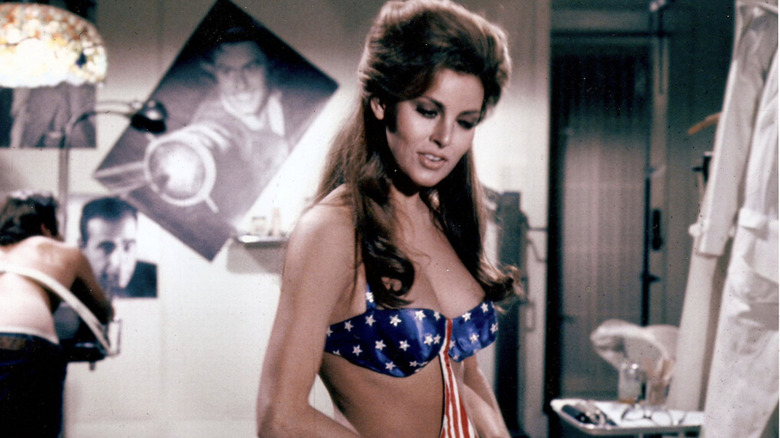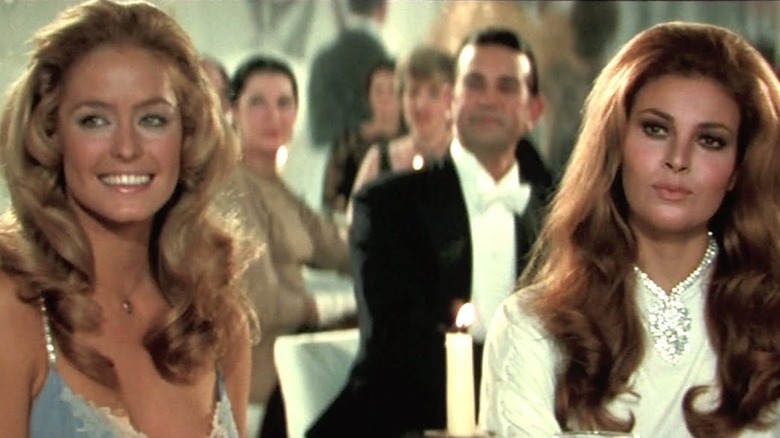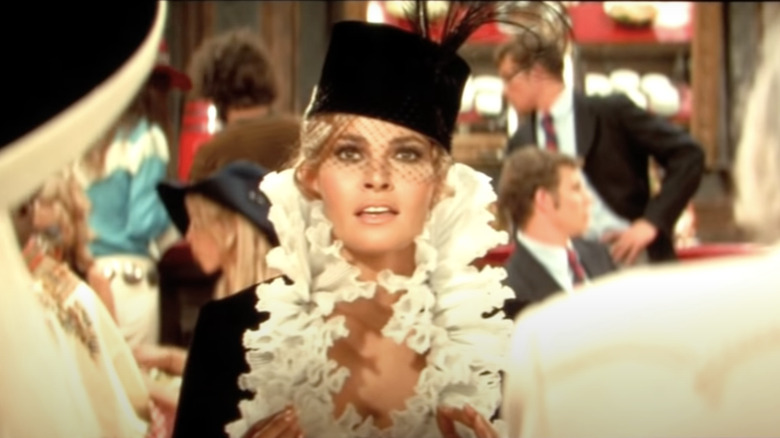Myra Breckinridge Was A Chance For Raquel Welch To Evolve Her 'Sex Symbol' Image
It's not a secret that Hollywood has a really sordid history with the way transgender characters have been presented on film. While bigoted pundits like to pretend that trans people and trans representation in entertainment is somehow a new concept, films like "Myra Breckinridge" were shocking and subverting audience expectations over half a century ago. Unlike the transgender media of our current era that often put cis men like Jared Leto, Eddie Redmayne, and Jeffrey Tambor in drag, "Myra Breckinridge" instead chose to cast Raquel Welch, an international sex symbol at the time, in the titular role.
The film was an adaptation of Gore Vidal's controversial book of the same name, a title that was equal parts bestseller and banned text. It's one of the earliest known novels to feature a protagonist who has undergone gender affirmation surgery and dissects themes of feminism, gender performance, America's unhealthy relationship with toxic masculinity, the patriarchy, so-called "deviant" sexual practices, and the broken Hollywood system, and it did so through the lens of over-the-top camp and bad taste.
"Myra Breckinridge" was and continues to be an extremely polarizing film, with as many die-hard fans existing as there are those who deem the film to be one of the worst in history. But the main draw was not just the marketing ploy of the film being about "Myron-who-becomes-Myra," but that Raquel Welch was leading an unbelievably stacked cast including John Huston, Farrah Fawcett, John Carradine, George Furth, Mae West, and future household names like Tom Selleck, Dan Hedaya, and Toni Basil (yes, the woman who sang "Mickey").
For Welch, it was her first "real role," and the one that helped show the world that she was more than just a bombshell.
A groundbreaking role for the ages
Raquel Welch's legacy as a sex symbol is well documented, as a huge poster of her from "One Million Years B.C." is used to cover the increasingly deep escape hole in Andy Dufresne's jail cell in "The Shawshank Redemption." Author Peter Haining wrote the book on Welch's career evolution, titled "Raquel Welch: Sex Symbol to Super Star." Despite the mixed reactions to the finished product of "Myra Breckinridge," the starlet's role was a game changer. He notes in the book that, "Raquel herself was cautious in her first pre-filming statement to the press, realizing only too well because of the story and the other actors who were being lined up to appear with her (Rex Reed, John Huston, Farrah Fawcett, and the veteran Mae West) that the months ahead would be fraught with pitfalls."
Welch would say that the role of Myra wasn't her "dream part," but acknowledged the part as the first "real role" she had ever been offered. At this point in her career, Welch was almost exclusively playing bombshell roles, like Lust in the original "Bedazzled" with Peter Cook and Dudley Moore. "It's the first time I'll be able to exercise myself as a comedienne," she was quoted as saying in the book. "Image? I don't think one role, even this one, can hurt that. As a matter of fact, the whole campy, sex symbol thing has gone too far in one direction as far as I'm concerned. Playing Myra will probably do me more good than harm."
Regardless of the critics' feelings on the film overall, Welch was right. Her performance in "Myra Breckinridge" opened doors for continued roles, like her Golden Globe-winning performance in "The Three Musketeers."
'Myra Breckinridge is a dish, and don't you ever forget it'
In hindsight, the role of Myra Breckinridge should have been played by an actual trans actress (Candy Darling, for example), but the fact the role was given to Raquel Welch is still more progressive than even today's trans representation. Rather than putting a male actor in drag, Myra was able to live as a strong, feisty, sexy, dangerous, undeniably cool woman. Trans women are women, and showing audiences that a trans woman could also be one of the most prominent sex symbols in history is revolutionary.
Director Mike Sarne wrote in the February 1971 issue of Films and Filming (via We Are Cult) about the appeal of the character, saying that she was, "feared for what she says about America, attacked for being too outspoken, hated because she laughs too loud, Myra Breckinridge has lost the chic of New York's cocktail parties and acquired a kind of underground celebrity among the f****t freaks and dope addicts, the rejects from your 'normal' society, the people who love her for being daring and for fighting their battles..." Welch was able to use her public image as a sex symbol as a vehicle to tackle the status quo, and permanently shake things up in Hollywood.
As she so famously says in the film, the first use of the big MF in cinema history, "Myra Breckinridge is a dish, and don't you ever forget it, you motherf*****s, as the children say nowadays."


